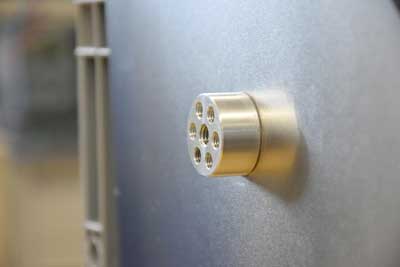| Posted: Apr 24, 2018 |
Nanosculpturing process to join metals without welding
(Nanowerk News) Welding is still the standard technique for joining metals. However, this laborious process carried out at high temperatures is not suitable for all applications. Now, a research team from the "Functional Nanomaterials" working group at Kiel University, together with the company Phi-Stone AG from Kiel, has developed a versatile alternative to conventional welding and gluing processes. Based on a special etching process, it enables aluminium and aluminium alloys to be joined with each other as well as with polymers, forming a durable and strong joint (Nanoscale Horizons, "Making metal surfaces strong, resistant, and multifunctional by nanoscale-sculpturing").
|
|
They will present the prototype of a mobile joining unit at the Hannover Messe (23 - 27 April). They plan to commence mass production in future, after feedback from customers.
|
 |
| The aluminium flange is firmly attached to the aluminium wall. (Image: Siekmann, CAU)
|
|
When welding, components are joined by locally melting them at the connection point. However, the high temperatures required for this influence the material in the so-called heat-affected zone, causing structural as well as optical changes. It also requires special safety precautions and appropriately qualified staff.
|
|
In contrast, the process developed by the Kiel University research group led by Professor Rainer Adelung not only spares the materials to be joined, but it is also easier and more flexible to use, even in hard-to-reach places such as corners or upside down on the ceiling. In just a few minutes, metals can be permanently connected with each other, but also with polymers.
|
|
The team envisages areas of application such as ship, aircraft or vehicle production. The process is particularly well-suited for subsequently attaching components in existing constructions, for example, in the interiors of ships or cars, explained Adelung regarding possible applications.
|
|
"The high temperatures of welding will destroy surfaces that have already been treated and painted, for example. Our process, on the other hand, works at room temperature without special protective measures," said Adelung.
|
|
To be able to connect metals, the Kiel research team uses its "nanoscale sculpturing" process to roughen the surface with a precise electro-chemical etching procedure, so that a fine, rectangular hook structure is created on the micrometre level. When two of these treated surfaces are inter-locked using an adhesive, a strong joint is created which is very difficult to break.
|
|
"If something breaks at all, then perhaps the actual adhesive or the material itself, but not the connection point", said Ingo Paulowicz, board member of Phi-Stone AG. "The nanoscale sculpturing process thus opens up completely new possibilities in the field of joining technology, but also entirely new combinations of materials, such as aluminium with copper or with silicone. This could be interesting for medical technology, for example," added Adelung.
|
|
In order to use this joining process in industry, the Kiel University team and Phi-Stone AG have now developed a mobile and easy-to-use prototype called "Metalangelo". Using customised etching cells produced via 3D printing, metal surfaces can be precisely processed at room temperature. Together with their first customers, they want to include customer requirements and develop the prototype to market-readiness. Two patents have already been registered in this regard.
|
|
The name of the prototype references to the renaissance sculptor Michelangelo, and emphasises the basic principle of the new process: the directed modification of surfaces - in the case of the Kiel research team, however, metal instead of marble.
|
|
From 23 - 27 April 2018, the research team will present its prototype at the Kiel University booth at the Hannover Messe, and demonstrate the process daily, live at 1:30pm (Hall 2, Research & Technology, Booth C07). Professor Rainer Adelung will also present the new connection process in a lecture on Tuesday 24 April 2005 at 2pm and 4pm.
|

